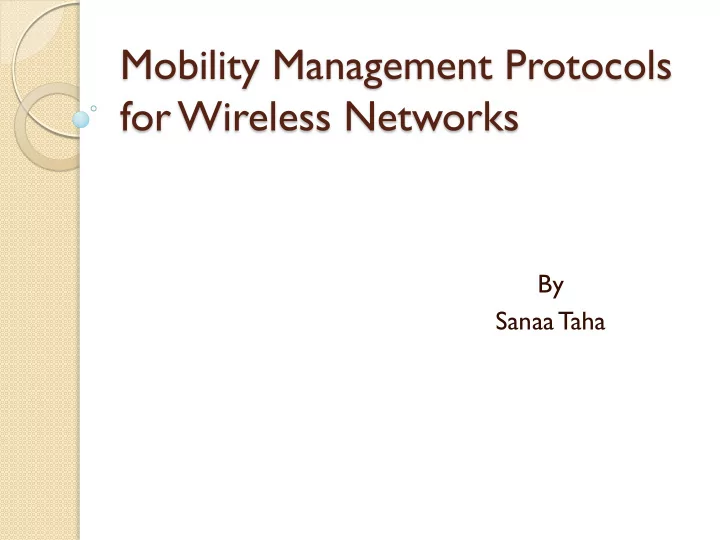

Mobility Management Protocols for Wireless Networks By Sanaa Taha
outline Mobility Management Mobility Management Models Host-based Mobility Management Protocols Network- based Mobility Management Protocols Which is the best ?! Conclusions Sanaa Taha MMPs for Wireless Networks 2
Mobility Management Fundamental technology used to automatically support MTs enjoying their services while simultaneously roaming with uninterrupted communication Most important and challenging problem for seamless access of wireless networks Location management and Handover management Sanaa Taha MMPs for Wireless Networks 3
Location Mobility Database architecture design Messaging Procedure design Transmission of signalling Security Dynamic DB updates Querying delays T erminal Paging Paging delays Sanaa Taha MMPs for Wireless Networks 4
Handover Management Intracell HO / Intercell HO Soft HO/ Hard HO Pkt processing Signalling load Optimizing connection BW reassignment Refining QoS Sanaa Taha MMPs for Wireless Networks 5
How to choose MM protocol? Fast handover Seamless Handover ( Pkt loss = 0) Signalling Overhead ( ctr data load, DB access) Routing efficiency QoS Fast Secrity ( key exchange) Special changes Sanaa Taha MMPs for Wireless Networks 6
Mobility Management Models 1- General Mobility Management Model Sanaa Taha MMPs for Wireless Networks 7
Mobility Management Models 2- Hierarchical Mobility Management Model Sanaa Taha MMPs for Wireless Networks 8
Host-based Mobility Management Protocols General Model/ Macro mobility Mobile IP ◦ location-independent routing ◦ Movement detection and agent discovery ◦ Registration ◦ Tunneling and routing (triangular routing) ◦ Transparency to upper layers ◦ High latency handoff ◦ High signalling load Sanaa Taha MMPs for Wireless Networks 9
MIPv6 Bigger address space Support for address renumbering Improve header processing Reasonable security The problem of reverse tunnelling is solved without affecting the operation of ingress filtering (Optimization route) Sanaa Taha MMPs for Wireless Networks 10
Host Identity Protocol Separates the end-point identifier and locator roles of IP addresses Host Identity name space based on PKI Provides secure methods for IP multihoming and mobile computing IP addresses are replaced with Cryptographic host Identifier Cryptographic keys are self-generated Sanaa Taha MMPs for Wireless Networks 11
Network based Mobility Management Protocols Micro/ Intra domain mobility Fast handoff Reduction in pkt loss Reduction in mobility-related signalling Support for multipath distribution techniques- high transmission reliability Support for QoS Sanaa Taha MMPs for Wireless Networks 12
Cellular IP – Proxy MIP Sanaa Taha MMPs for Wireless Networks 13
Hierarchical MIP Sanaa Taha MMPs for Wireless Networks 14
Handoff-aware wireless Access Internet Infrastructure (HAWAII) Sanaa Taha MMPs for Wireless Networks 15
What is the best ?! Features MIPv6 MobiSplit IP 2 MN FMIPv6 PMIPv6 Local/Global domain Global Both Global Global Local Pkt loss Yes Yes Yes No/Yes Yes Muli-homing No Yes No No Yes Air interface- Traffic High Low Low High Low overdead Terminal Yes No Yes Yes No Modification Tunneling overhead High Low No High No at MN Sanaa Taha MMPs for Wireless Networks 16
What is the best ?! Number of stations Handoff rate Number of CNs Wired link delay Random movement Traffic sources (video, voice) Sanaa Taha MMPs for Wireless Networks 17
Conclusions MIPv6 is the standard global mobility management protocol, however it does not support multi-homing MNs FMIPv6 mitigates MIPV6 by proactively perform the handover process Local mobility management protocols do not help for high mobility environment (opinion!) Solutions? …. Merging Sanaa Taha MMPs for Wireless Networks 18
Thank you Questions??
Recommend
More recommend